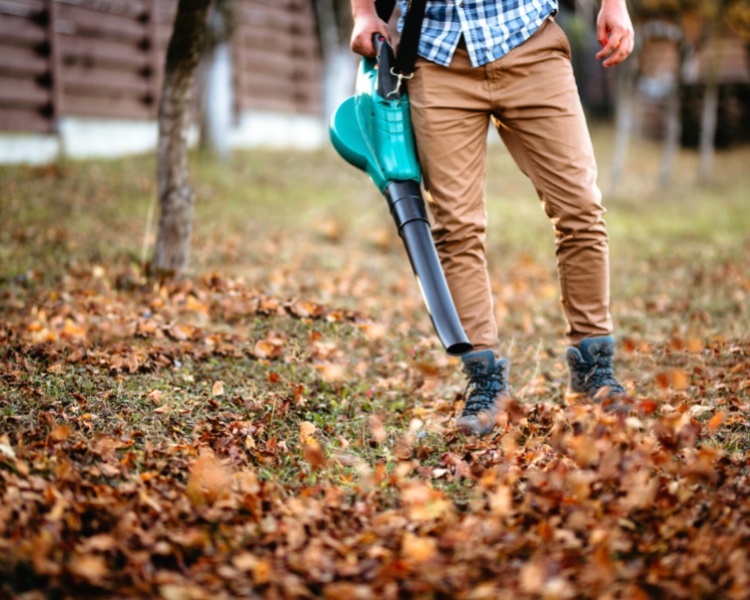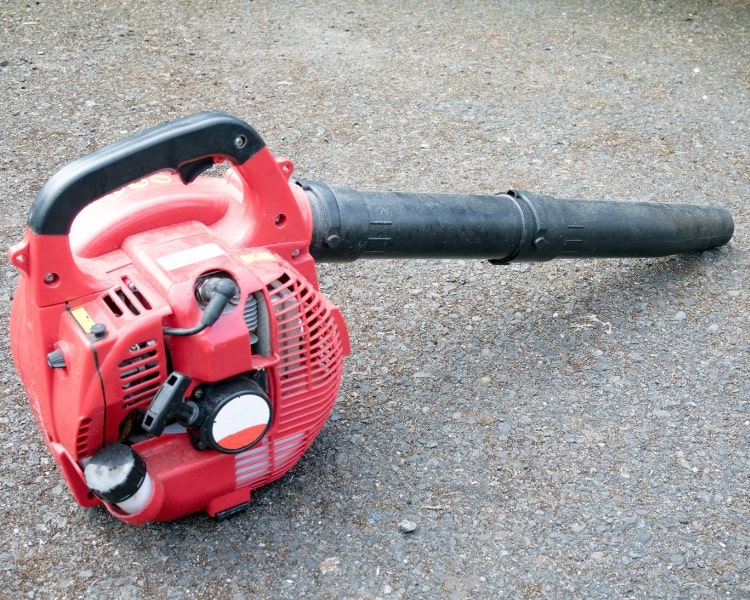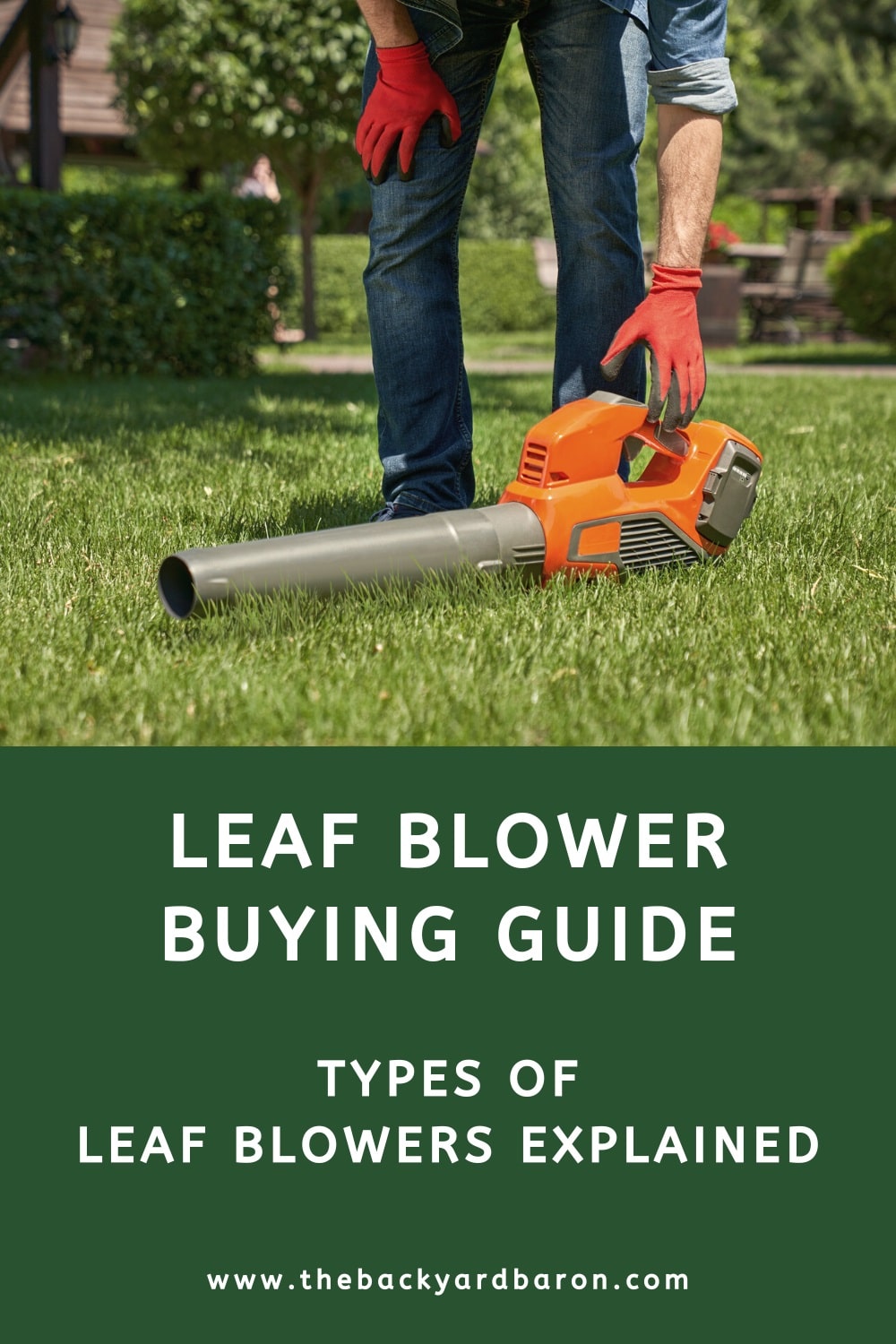I may earn a small commission from purchases made through product links on this website at no extra cost to you. As an Amazon Associate I earn from qualifying purchases.
Last updated: January 21, 2024
A comparison guide with an outline of the different types of leaf blowers, such as gas-powered versus electric and handheld versus backpack.
If you have a reasonably sized yard with more than a few trees, you’re going to have to deal with large amounts of leaves when fall kicks in.
Cleaning up those leaves isn’t necessarily a big deal, but the bigger your yard and the more trees you have, the more time-consuming this clean-up job becomes. In that case, it may be worth purchasing a leaf blower.
In this article, I will walk you through the different types of leaf blowers you can buy today to help you make an informed decision. All of these leaf blowers come with pros and cons, and also their own price tags.
Quick navigation:
Types of Leaf Blowers
Let’s first outline the different types of leaf blowers, and further below, we’re going to look at the different ways leaf blowers can be powered.
There are three different types of leaf blowers that you can choose from:
- Handheld leaf blowers
- Backpack leaf blowers
- Walk-behind leaf blowers
Let’s discuss these three types in more detail to help you determine which machine might be best for your personal needs.
1. Handheld Leaf Blowers
Handheld leaf blowers are by far the most common in household backyard environments. They are usually the most affordable while still offering more than enough performance to manage the yard.

As the name suggests, a handheld leaf blower has a big handle at the top to operate the blower with one hand. They often come with a handy shoulder strap, making them even easier to carry around.
I will discuss the power source in more detail further below, but with handheld blowers, you can choose between corded electric, battery-powered electric, and gas-powered.
Top-Selling Handheld Leaf Blower: Makita XBU02PT
The Makita XBU02PT is a durable, battery-powered leaf blower that comes with a max power rating of 473 CFM and a decent speed rating of 120 MPH. It can easily move dry leaves an impressive distance and has the power to lift stuck-on debris and years of wet leaves.
At 16 pounds with the batteries in, the Makita is a bit heavy, but considering the durability and quality of the build, this extra weight shouldn’t come as a surprise. Another factor that contributes to that extra weight is the double battery system. This 36V tool runs on two lithium-ion 18V batteries. The set comes with two 5.0Ah batteries and a dual-port charger, delivering a run time of about 15 minutes on high and 30 minutes on medium.
Like other battery-powered blowers, this one offers variable speeds. There is no turbo charge button, but the rolling dial provides six different speed settings to accomplish any job you can throw at it.
- Delivers up to 28 minutes of run time at mid-speed (15,800 RPM) using two 18V...
- BL Brushless motor delivers up to 120 MPH air velocity and 473 CFM of air volume
- Sound pressure rating of 61 dB(A); measured per ANSI B 175.2 standard
2. Backpack Leaf Blowers
A backpack leaf blower is literally just that: a leaf blower that you can carry around like a backpack. For some, that will be more comfortable than carrying a handheld machine.

They’re typically more expensive than their handheld counterparts and can generally deliver a bit more power. They are also available as both electric and gas-powered.
If your yard is reasonably large and you’re looking for a bit more comfort when cleaning up leaves, investing in a backpack leaf blower is definitely something to consider.
Top-Selling Backpack Leaf Blower: EGO Power+ LB6000
The EGO Power+ LB6000 features a CFM rating of 600 and can push air out at 145 MPH, making it suitable for large yards and other big jobs.
EGO has made a name for itself in the yard tool industry thanks to its impressively long-lasting line of interchangeable batteries. If you already have some EGO tools, this product is a great buy since you don’t have to pay extra for additional batteries.
If you do need batteries, then we recommend the 2.5Ah battery. This lightweight battery charges on the included charger in just 40 minutes. On low, it can run the EGO blower for about 75 minutes. On high, you’ll get about 15 minutes out of it.
In addition to impressive battery life, this tool features a variable speed lever and turbo boost button. The backpack portion is comfortable to wear and includes an adjustable hip strap.
- Turbo button delivers 600 CFM, up to 160 MPH
- Up to 180 minutes of runtime on a single charge with a 56V 7.5Ah ARC Lithium...
- Variable speed control from 260 to 500 CFM
3. Walk-Behind Leaf Blowers
Walk-behind leaf blowers are suitable for managing large areas. They are the most powerful type of leaf blower and are designed to cover larger areas of leaf build-up.

The CFM (cubic feet per minute, see below) produced by walk-behind leaf blowers typically far exceeds the CFM produced by handheld and backpack-style leaf blower machines, which is what makes them so suitable for large areas.
But if you’re looking for a leaf blower for use in the backyard, you’re probably not going to need an expensive walk-behind leaf blower.
Electric vs Gas Leaf Blowers
Leaf blowers obviously need power in order to do their job, and this comes down to the choice between electric and gas:
- Electric leaf blowers
- Corded
- Cordless (battery powered)
- Gas powered leaf blowers
- 2-cycle
- 4-cycle
Let’s discuss the electric vs gas-powered comparison in more detail.
1. Electric Leaf Blowers
Electric leaf blowers are either corded or cordless.
When they are corded, you’re going to need to plug them into an electrical outlet. When they are cordless, they are powered by a rechargeable battery.
An electric leaf blower is much more common in an average household environment, as it is more affordable, less noisy, and perfect for smaller spaces to manage.

Pros and Cons
Electric leaf blowers are far less noisy than gas-powered machines, which is an important consideration, especially when living in a dense neighborhood.
Another advantage of electric leaf blowers is that they are reasonably environmentally friendly compared to gas-powered machines and are typically lighter.
The biggest drawback with electric leaf blowers is that there are limitations in flexibility. With a corded machine, you can only go so far as the length of the cord (although they are pretty long), and with a battery-powered machine, you can only keep blowing until the battery runs out.
2. Gas Powered Leaf Blowers
A gas-powered leaf blower is like a car in the sense that it needs gasoline in order to operate.
Gas-powered leaf blowers typically come as a 2-cycle or as a 4-cycle machine. Read this handy guide for an outline of the differences between these two engine types in the context of lawn care products.
Gas-powered leaf blowers are typically more expensive, more powerful, and also noisier than their electric counterparts. That said, with handheld leaf blowers, you will find that modern electric machines often outperform gas-powered models.
While they are certainly suitable for backyard work, gas-powered leaf blowers are more common in commercial and industrial environments, as they offer more power, flexibility, and durability.

Pros and Cons
The main advantage of using a gas-powered leaf blower over an electric leaf blower is performance. A gas motor, in general, is able to deliver more power than an electric machine can.
The other advantage of gas leaf blowers is that they offer a lot of mobility and flexibility. You can use them anywhere and anytime you like, as long as you have gasoline available. There is no cord to deal with it, and a full tank offers a much longer runtime than a fully charged battery.
The biggest drawback of gas-powered machines is that they’re not the most eco-friendly way to clean up leaves in your garden. The fumes aren’t pleasant, so there is a pollution element to consider.
The other drawback is that they are typically much noisier than their electric and battery-powered counterparts, so your neighbors may not be too happy. Also note that they are often heavier than electric models.
Performance Considerations
When looking for a new leaf blower, apart from the type of leaf blower to choose, you will also need to look at its performance measurements, especially if you have a larger yard to look after.
Two of the most important measurements are:
- CFM (Cubic Feet per Minute)
- MPH (Miles per Hour)
Let’s discuss these two measurements in more detail.
1. CFM
CFM stands for cubic feet per minute and is a measurement of volume.
It measures how much air is pushed out of the leaf blower pipe per minute. The higher the CFM, the more air is pushed out, and the more material can be blown away.
2. MPH
MPH stands for miles per hour and is a measurement of velocity.
It measures how fast the air leaves the leaf blower pipe. The higher the MPH, the faster air is pushed out, and the further material can be blown away.
When searching for a new leaf blower, these two measurements are almost always mentioned, as they determine how much power the leaf blower can deliver. The higher these two measurements, the better.
CFM and MPH are typically impacted by the motor type (electric, 2-cycle gas, 4-cycle gas), motor size, pipe design, and impeller design.
To give you a practical example, a smaller pipe usually leads to an increased MPH but also leads to a decreased CFM.
Average CFM and MPH ranges per leaf blower type:
- Handheld:
300-600 CFM and 100-250 MPH - Backpack:
400-900 CFM and 150-250 MPH - Walk-behind:
1000-8000 CFM and 150-250 MPH
Read my guide about leaf blower CFM and MPH measurements to learn more about these important buying factors.
Conclusion
To summarize, you have the following options to consider when looking for a new leaf blower:
- Handheld leaf blower
- Corded electric
- Battery powered electric
- Gas powered
- Backpack leaf blower
- Corded electric
- Battery powered electric
- Gas powered
- Walk-behind leaf blower
- Gas powered
Complicated? It doesn’t need to be.
Simply consider the size of your yard, how much leaf build-up you typically have, and how much money you wish to spend on a new leaf blower.
For an average-sized backyard with normal leaf build-up, a corded electric handheld leaf blower would be my recommendation. That is the most affordable and the easiest to handle leaf blower option.
But there is another option: the old-fashioned manual way. Have a look at my list of different types of rakes to see if using a rake to clean up leaves might be a viable solution for your backyard.



